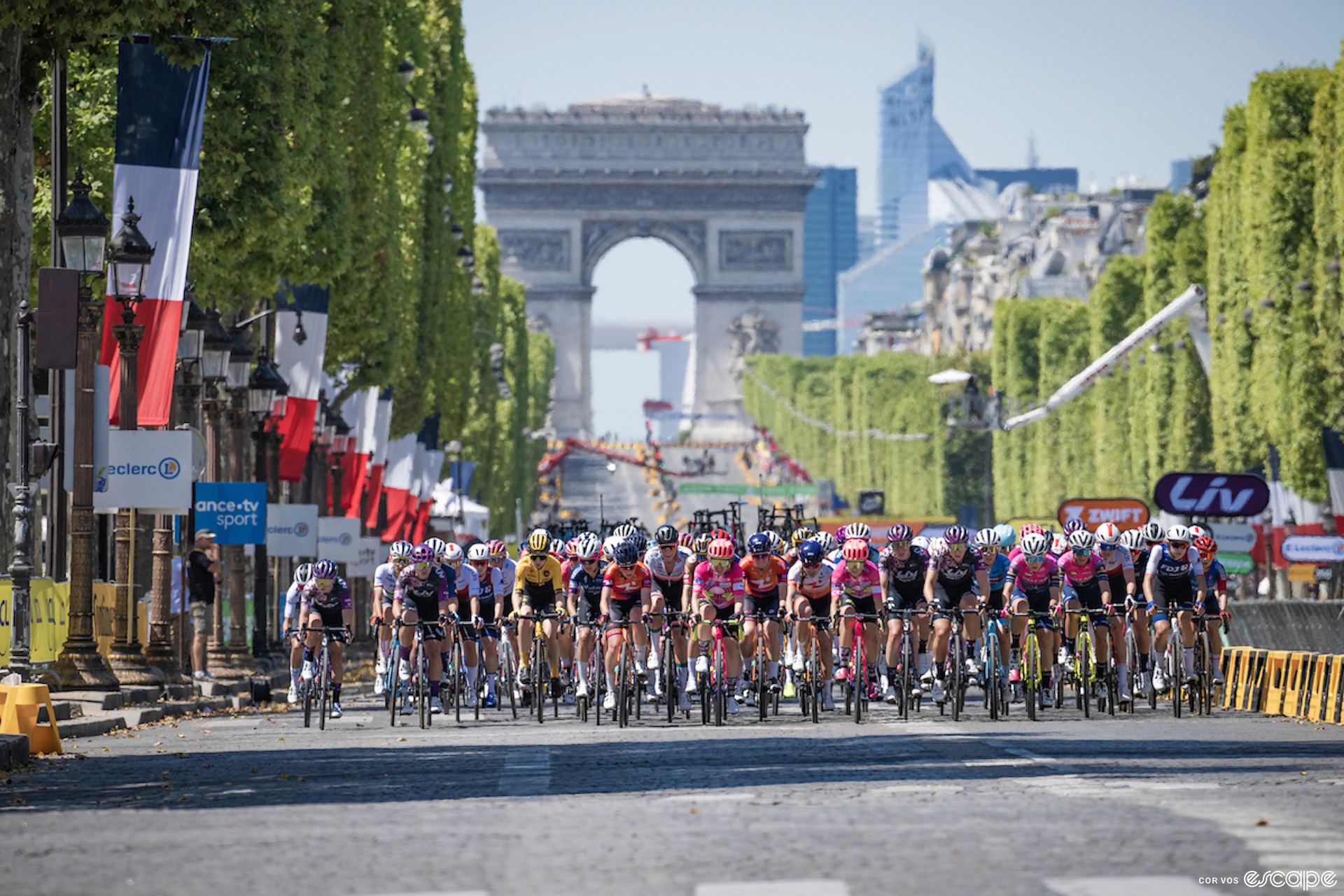Logistically, it made sense for the first Tour de France Femmes avec Zwift to start in Paris, on the Champs-Élysées, where the men would pass through hours later. The roads were lined with fans as Lorena Wiebes sprinted into the first yellow jersey, but a question lingered: were the fans there for the men and just stumbled upon the women’s race?
By the third stage, it was clear the women had their own draw – the crowds remained throughout the race, all the way to the Super Planche des Belles Filles.
For its second edition, the race start moved away from Paris to Clermont-Ferrand, a clear sign that the Tour de France Femmes is ready to stand on its own two feet; a separate event from the men’s. Crowds at the start of the first stage packed the city centre, kids in polka-dot T-shirts could be seen leaning through barriers to catch a glimpse of Marianne Vos, Annemiek van Vleuten, and Juliette Labous.
“To be honest, at first, I was like, ‘Oh, I want the race to start in Paris’,” said Joanne Kiesanowski, director for Human Powered Health. “It’s iconic to race on the Champs-Élysées. But I think last year we proved, in year one, that we can stand alone, and we can have our own race.”
With the history and the tradition tied to the Tour de France name, the women’s event will always have some lingering strings connecting it to the men’s race. But in Clermont-Ferrand on Sunday, with the men racing 426 km away, the women have the chance to chart their own path.
“It would be really boring now if we start the Tour de France every year on the Champs-Élysées,” said Ina Teutenberg, Lidl-Trek sports director. “We’re doing a different route when we start here. But I’m not thinking so much about if it’s good or not; I don’t really think it matters where it starts or where it finishes.”
The change of Grand Départ offers the women more options for the following seven stages, as it does the men. If the women were to start every season in Paris when the men wrap up their 21-day race, it would limit the options, especially in terms of mountain stages. The new start in the second edition allowed the organizers to include the Col du Tourmalet, for example.
There was an electric feeling in the air at the women’s Grand Départ. The excitement was contagious, and as riders rode to sign on the crowds only grew. As the start inched closer more and more people could be seen hovering outside of team buses, eagerly checking out team bikes already locked and loaded on top of team cars, and hoping for a glimpse of any of the riders.
“Now I just looked down, you know, and this sea of people down here and it’s amazing,” said Kiesanowski, standing outside the Human Powered Health team bus ahead of the first stage. “I think that we can stand alone, and we can be completely separate from the men’s race and show that there are enough people,” said Kiesanowski.
“I think Rotterdam next year is already exciting. In the third edition, we can go to Rotterdam for three days and then come to France. That’s already showing a lot of growth, you know, that we can have a Grand Départ in another country, and obviously, the Netherlands is cycling-mad. So, it’s only going to be bigger.”
The decision to start the third edition of the Tour de France Femmes in Rotterdam was an interesting one from the organizers. On the one hand, the men often start outside of France, but for the women who only race eight stages, removing even one stage from the country feels like a weird decision. But as Kiesanowski said, the Dutch are cycling-mad, and for them to have the start of the Tour in their backyard will only bring more attention to the race.
It’s a testament to the success the race saw from the moment the flag dropped in Paris last year that Rotterdam would front the money to host not only the first stage of the 2024 edition but the first three.
When he first announced the women’s Tour, Christian Prudhomme, director of the Tour de France, said that if the women’s race lost money, it would be shut down.
“There was a reason why [the women’s Tour de France held between 1984-89] only lasted for six years, and that was a lack of economic balance,” Prudhomme said in an interview in 2021, before the inaugural Tour de France Femmes had taken place. “What we want to do is create a race that will stay the course, that will be set up and stand the test of time. What that means is that the race cannot lose money.
“Today, all the women’s races that we organise lose us money,” Prudhomme added.
Much of the success of the Tour de France Femmes race can be attributed to Zwift, who signed on for multiple years and who hope the race will grow in stages and prestige over the years. Around the start on Sunday fans and riders alike donned orange and pink “Watch the Femmes” cycling caps, and orange banners could be seen from every angle.
Only time will tell if the women’s event can distance itself from the men’s, but the start taking place outside of Paris is the beginning of the test.
Throughout the eight stages, the crowds will dictate whether or not it was a good idea to host the first two stages far enough from Paris that the fans who follow the men’s event won’t be able to rejoin the women’s for a day or two. It would be surprising not to see the Col du Tourmalet lined with enthusiastic support from all over the world come Saturday.
What did you think of this story?

